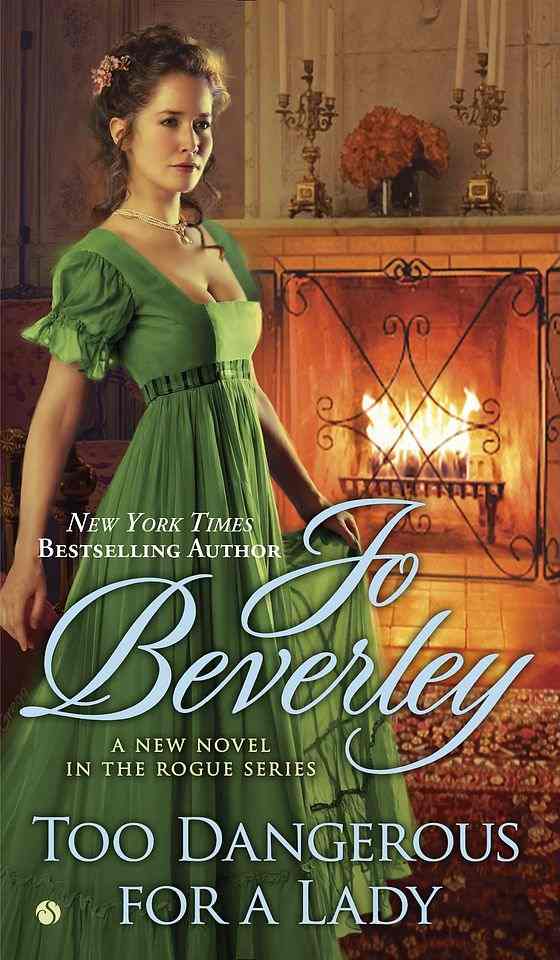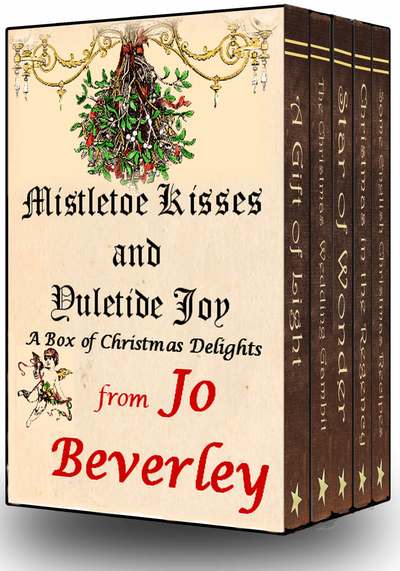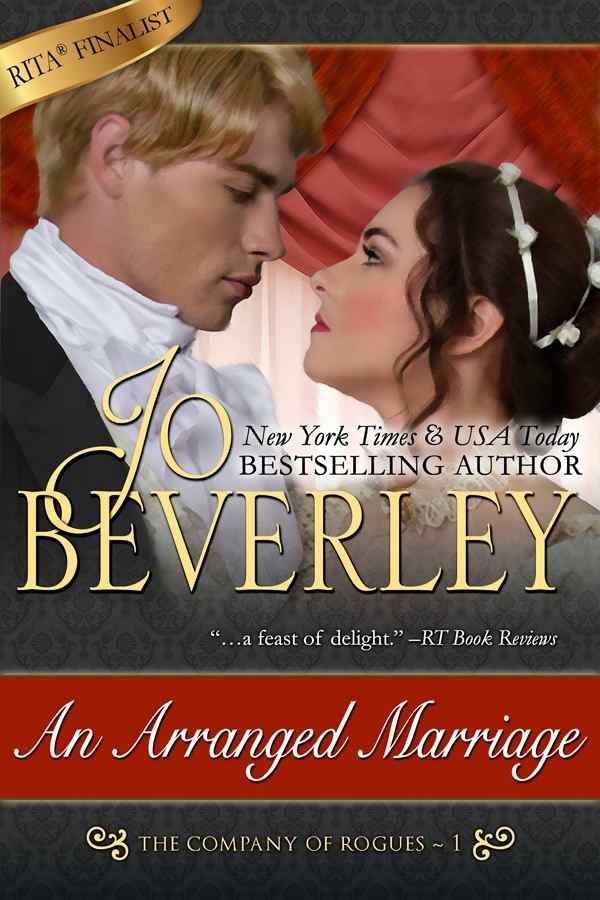
Too Dangerous for a Lady
A novel in the Rogues World
Click on the cover to read more.
Click on the box below to visit and "like" my Facebook page.

All recent and upcoming books.

Five time RITA winner.
(If you find this useful, you can say thank you by buying one of my books.
ENGLISH TITLES IN THE 18TH AND 19TH CENTURIES
by Jo Beverley
Member of the RWA Hall of Fame for Regency Romance.
"Arguably today's most skilful writer of intelligent historical romance." Publishers Weekly
This brief run-down of English titles is for use by fiction writers. It is by no means comprehensive, but covers the more common situations arising in novels set in the above periods.
At the end I address the question of choosing fictional titles.
The English peerage basically runs according to primogeniture, ie the eldest son gets nearly everything. If a peer has no eldest son, the title and possessions that belong to it go to the next male heir, probably a brother or nephew.
There are a very few titles that can pass to a female if there is no direct heir, but they will revert to the male line when the lady bears a son. (Such as the monarchy.) Some titles can automatically pass through a female heir (when there is no male heir) and most can be revived by subsequent generations by petitioning to the Crown. But that's getting into more complicated areas. If your plot depends on something unusual, please do research it thoroughly before going ahead.
The eldest son is called the heir apparent, since he is clearly the heir. If there is no such son, the next in line is called the heir presumptive since, no matter how unlikely (the duke is actually an ancient Benedictine Monk on his death bed) the possibility of a closer heir being created is still there. Thus an heir presumptive does not hold an heir's title, if any. (See below about heir's titles.)
If a peer dies leaving a wife but no son, the heir inherits unless the widow says she might be with child. It is for her to do that. If she stays silent, it is assumed that she is not. If she's pregnant, everything waits until the child is born.
An heir must be legitimate at birth to inherit a title, though that could mean a marriage ceremony performed while the mother is in labor. A peer may raise bastards with devotion and/or marry the mother later, but a bastard child can never be his legal heir.
Peers automatically had seats in the House of Lords. Note, however, that courtesy titles (those held by heirs) do not give seats, or any of the other privileges of the peerage.
Most peers do not use their surnames as their title. Thus, the usual pattern would be something like Sebastian Burgoyne, Earl of Malzard. He is Lord Malzard never Lord Burgoyne. (Or, for that matter, Lord Sebastian.) As an author, you might like variety, but take as a general rule is that no one ever had two forms of address.
THE RANKS OF THE PEERAGE
A) Leaving aside royalty, the highest rank is DUKE.
His wife is the DUCHESS. They will be duke and duchess of something, eg. Duke and Duchess of Ithorne. Address is "your grace", though familiars may address them as Duke and Duchess eg "Fine weather for shooting, eh, Duke?" or may address the duke by title. "Care for more port, Ithorne?"
NOTE that the duke will also have a family name, ie. surname (such as Cavendish) but will not use it in the normal course of events. The duchess does not use the surname at all. If Anne Pitt marries the Duke of Stone (whose family name is Cherry), she will be Duchess of Stone and will informally sign herself Anne Stone, not Anne Cherry.
The duke's eldest son is his heir and will have his father's second-best title as his courtesy title. Nearly all peers have a number of titles marking their climb up the ranks. The heir to a duke is often the next lowest ranking peer, a marquess (or marquis -- spelling is optional, but both are pronounced markwess.) The title could, however, be an earldom, or even a viscountcy.
Remember, a courtesy title does not give the holder a seat in the House of Lords or other privileges of the peerage.
If the heir has a son before the heir becomes duke, that son will take the next lowest title as a courtesy title. If the heir dies before his father, his eldest son becomes the heir apparent and takes his father's title.
Apart from the heir, a duke's sons are given the courtesy title Lord with their Christian name, eg. Lord Richard Somerset. Lord Peter Wimsey. They are never Lord Somerset or Lord Wimsey.
All duke's daughters are given the courtesy title Lady, first name, surname eg. Lady Mary Clarendon. (Never Lady Clarendon.) If they marry a commoner, they retain the title. If Lady Mary marries Mr. Sticklethwait, she becomes Lady Mary Sticklethwait. If she marries a peer, she adopts his title. If Lady Mary marries the Earl of Herrick, she becomes Countess of Herrick, ie. Lady Herrick. If she marries the holder of a courtesy title, then she may use his title or her birth title as she wishes.
I'm hammering this home, but it's the most common error in novels. In all cases, the titles Lord or Lady "first name" "surname" (eg Lady Anne Middleton) and Lord or Lady "last name" or "title" (Lady Middleton) are exclusive. No one can be both at the same time. Moreover, Lord or Lady "first name" is a title conferred at birth. It cannot be gained later in life except when the father accedes to a title and thus raises his family.
So, Lady Mary Smith is not Lady Smith and vice versa.
Lord John Brown in not Lord Brown and vice versa.
If Mary Smith marries Lord Brown she becomes Lady Brown, not Lady Mary.
(If she marries Lord John Brown, she becomes Lady John Brown. Yes, it may sound odd to modern ears, but the past is, as they say, a different country. That's the charm of historical fiction.)
B) Next in rank is a MARQUESS (As above, it can be spelled marquis or marquess, but in either case is pronounced markwess.)
He will be Marquess of something, eg Marquess of Rothgar. His wife is the MARCHIONESS. (Pronounced "marshuness".) He is the Marquess of Rothgar, or Lord Rothgar, or Rothgar to his familiars, and his wife is the Marchioness of Rothgar or Lady Rothgar. She will sign herself "firstname" "title" eg. Diana Rothgar.
His heir apparent takes his next highest title as a courtesy title. All other sons have the title Lord "firstname" "surname". All daughters have the title Lady "firstname" "surname". Details are as for duke.
C) Below marquess is EARL.
He will nearly always be earl of something. His wife is the COUNTESS. He is referred to as "the Earl of Saxonhurst" or "Lord Saxonhurst", or "Saxonhurst" to his familiars. Some earls do not use "of" as with Earl Spencer, b and in that case the family surname will be the same as the title -- in this case, Spencer -- but this is sufficiently unusual that I think it should be avoided in fiction unless it's a crucial plot point.
His wife is the Countess of Saxonhurst, or Lady Saxonhurst, and she will sign herself Minerva (or Meg -- viz Forbidden Magic -- Saxonhurst.
As with a duke, the earl's heir will take the next lowest title as a courtesy title, and the heir's son, the next again.
All daughters of an earl are given the courtesy title Lady "firstname"; -- see dukes. All details are the same. Younger sons of an earl, however, are merely "the honorable" which is not used in casual speech.
D) Next is a VISCOUNT (pronounced vycount.)
His wife is a VISCOUNTESS. He is not "of". He will be, for example, Viscount Middlethorpe, usually known as Lord Middlethorpe, or just Middlethorpe. His wife will be known as Lady Middlethorpe and will sign herself Serena Middlethorpe.
His heir has no special title. All children are known as the honorable.
E) The lowest rank in the peerage is BARON.
His wife is a BARONESS. NOTE that the terms baron and baroness are only used in England in the most formal documents, or when the distinction has to be made elsewhere. General usage is simply to call them Lord and Lady. She will sign herself "firstname" "title". Children as for viscount.
F) Next in rank -- and not of the peerage -- is BARONET.
A baronet is called Sir, first name, surname. eg. Sir Richard Wellesley. His wife is called Lady "surname"; eg. Lady Wellesley. NOT Lady Mary Wellesley unless she is the daughter of a duke, marquess, or earl. She will sign herself "firstname" "surname" such as Mary Wellesley.
His children have no special distinction. The title, however, is inheritable which distinguishes it from....
G) A KNIGHT
who is the same as a baronet in usage, but is a title for life only. His wife will be Lady "surname"
OTHER MATTERS
DOWAGERS
When a titled lady is widowed she becomes a dowager, but the practice has generally been not to use that title until the heir takes a wife, when there could be confusion as to who is the real Lady Middlethorpe. (As happens in my novel, Forbidden.)
Even if she has a daughter-in-law, in general usage she would still be referred to by the simple title unless there was likely to be confusion. So, if the Dowager Duchess of Teale was at a house party while her daughter-in-law was in London, people would not be constantly referring to her as the dowager duchess.
PEERESSES IN THEIR OWN RIGHT
There are a few, very few, titles that can pass to a daughter if there is no son -- the Royal Family, for example. In this case, the usage is the same as if they were the wife of a peer of that rank, but their husband gains no title from the marriage, just as the Duke of Edinburgh is not king.
A Peeress in her Own Right retains her title after marriage, and if her husband's rank is the superior one, she is designated by the two titles jointly, the inferior one last. Or she can say what form she wants to use. (eg The marchioness of Rothgar is also the Countess of Arradale by right. She chooses to be Lady Rothgar and Arradale in the most formal situations, Lady Rothgar in general, but Lady Arradale in private, especially when attending to her duties as Countess of Arradale. Unusual situations do tend to get complicated.) Her hereditary claim to her title holds good in spite of any marriage, and will be passed on.
Since the husband gains no title from such a marriage, it's possible to have the Countess of Arbuthnot married to Mr. Smith.
Her eldest son will be her heir and take her next lowest title. If she has no son, her eldest daughter will be her heir, but until she becomes the peer she will hold only the title that comes from her birth -- eg. Lady Anne -- if any, because an eldest daughter is always an heir presumptive. There might still be a boy.
COMMON PROBLEMS SEEN IN NOVELS
- Interchanging courtesy titles like Lady Mary Smith and Lady Smith.
- Interchanging peerage titles, as when Michael Downs, Earl of Rosebury is variously known as Lord Rosebury, Lord Downs, and Lord Michael Downs.
- Applying titles that don't belong, as when Jane Potts marries Viscount Twistleton and erroneously becomes Lady Jane, a title form that can only come by birth.
- Having the widow of just about anyone, but especially a peer, remarry before time has elapsed to be sure she is not bearing a child. Or rather, whose child it is that she bears!
- Having the heir presumptive assume the title and powers before the widow has made it clear that she's not going to produce an heir.
- Having an adopted son inherit a title. Legal adoption was not possible in England until the twentieth century, and even now an adopted son cannot inherit a title. Even if the son is clearly the father's offspring, if he wasn't born after a legal marriage, he cannot inherit the father's title. However, since they didn't have DNA testing, a child was assumed to be legitimate unless the father denied it from the first. Even if the son turns out to look suspiciously like the vicar, the father cannot deny him later. This, I assume was to avoid the chaos of peers coming up with all sorts of excuses to switch heirs on a whim.
- Having a title left in a will, which follows from the above. A title cannot be willed to whomever the peer in question chooses. It goes according to the original letters patent, which almost always say that it will go to the oldest legitimate male in direct descent. The property can be left elsewhere, unless it is entailed, but the title goes by legitimate blood.
- Having an heiress (ie a daughter without brothers) inherit a title and convey it to her husband. It could be done -- anything could -- by special decree of the Crown, but it was not at all normal.
The question was asked: When writing historical fiction, does one create a title for a character, or do you have to research a title and just use a disclaimer?
Answer: always make it up. When you've come up with a title you like, do an internet search to see if it exists. Also check The Peerage and do a search in Googlebooks advanced search. You can choose date of publication, so you could do a broad search there for the Earl of Glaringdangerously published between 1800 and 1830 and see if any reference turns up.
You don't want to give your fictional character a title that was in use at the time. The main reason is that it's uncouth to appropriate someone's identity. In addition, some, perhaps many, readers will be aware of the real peer which will destroy the fictional reality you're trying to create. Bear in mind that most peers were simple Lord xxxxxx, so you can't have an Earl of Smilingcharmingly when there was a Viscount Smilingcharmingly. If the title was in use in any way, don't use it.
Your internet search should pull up any other uses of the title, and life peerages mean there are lots today. They weren't around a hundred years ago, but it's still not couth to use their title in a fictional work set in the past. Most take their surnames as title, but that can cover a lot of ground. There's a Lord Sugar and a Lord Adonis, both men who've made their way in life from a simple start.
If you really like your title but it exists or existed, it may be possible to alter it and retain the quality that appeals to you. You may fancy Lord Amesbury, but he existed. You could have Lord Aymesbury or Lord Embury.
A good place to hunt for titles is on large scale maps that show the names of villages. Often remainder houses sell last year's large scale UK road atlases for under $10, or you can simply use googlemaps and zoom in. Same thing for surnames. Place names are often specific for certain areas of Britain, so if your character's family has been in Suffolk for generations, look at Suffolk villages for ideas for names.
Or you can get into genealogical records if you want something really local. That's how I came up with a smuggler called Melchisadeck Clyst!
I hope this helps, and though I'm pretty sure it's right it is open to debate and amendment. Please e-mail me at jo at jobevdotcom if you have comments.
Copyright Jo Beverley. You may link to this article or share it, but of you share it I ask that you observe the following rules. Please don't alter it in any way, and please keep the copyright notice in place. Don't use it to make money for yourself or your organization. If possible, include the URL of my web site so people can find out more about my books.
If you enjoyed this article, you could ![]() tweet about it
tweet about it
Click on it and you will be able to preview it before it goes.
I have an author page on Facebook, where I post fun news about life, research and books on most days. Click on the face!

However, Facebook doesn't send every message to everyone, so you might want to sign up for my newsletter below.

Like the historical part of historical fiction? Visit the Word Wenches blog.
If any of this web site is difficult to enjoy, please e-mail here
Back to the site menu
 MISTLETOE KISSES AND YULETIDE JOY
MISTLETOE KISSES AND YULETIDE JOY
The First Rogues Book